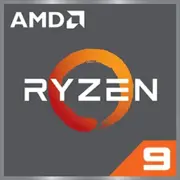AMD Ryzen 9 3900XT

AMD Ryzen 9 3900XT: Comprehensive Review of the 2025 Processor
Introduction
Even years after its release, the AMD Ryzen 9 3900XT remains in high demand among enthusiasts and professionals. This 12-core processor, launched in 2020, continues to be relevant due to its successful balance of price and performance. In 2025, it can be found for sale at a price of $250–300 (new, leftover stock), making it an attractive option for building entry-level and mid-range PCs. Let’s explore who this CPU is suitable for and what to consider when choosing it.
1. Key Specifications
Architecture and Process Technology
The Ryzen 9 3900XT is built on the Zen 2 microarchitecture (codename Matisse) and is manufactured using TSMC’s 7nm FinFET process technology. This ensures high energy efficiency: with a TDP of 105W, the processor delivers performance comparable to newer models.
Key Features:
- Precision Boost 2 and XFR: automatic overclocking up to 4.7 GHz depending on load and cooling.
- PCIe 4.0 Support: double the bandwidth compared to PCIe 3.0 (relevant for SSDs and graphics cards like the RTX 4070 and above).
- 64 MB L3 Cache: reduces latency for heavy applications.
Performance
- Geekbench 6: 1716 (single-core) / 9906 (multi-core).
- Cinebench R23 (2025): ~1300 (single-core) / ~20500 (multi-core).
- In games (e.g., Cyberpunk 2077 or Starfield), the processor delivers 90–120 FPS with the RTX 4070 at 1440p resolution but can become a bottleneck for high-end GPUs (e.g., RTX 5080).
2. Compatible Motherboards
Socket and Chipsets
The processor uses the AM4 socket, limiting motherboard choices to models released between 2019 and 2022. Compatible chipsets include:
- X570: best choice for overclocking (e.g., ASUS ROG Crosshair VIII Hero).
- B550: optimal balance of price and functionality (MSI MPG B550 Gaming Edge).
- A520: budget option with no overclocking support (Gigabyte A520M DS3H).
Important!
- Update the BIOS before installing the processor. For example, motherboards with X470/B450 chipsets require a BIOS version not lower than AGESA 1.2.0.0.
- For PCIe 4.0, choose motherboards with X570 or B550 chipsets.
3. Supported Memory
The Ryzen 9 3900XT works only with DDR4. Recommendations:
- Frequency: 3200–3600 MHz (optimal for Zen 2).
- Timings: CL14–CL16 (e.g., G.Skill Trident Z Neo 3600 CL16).
- Mode: dual-channel (2x8 GB or 2x16 GB).
Why not DDR5?
The Zen 2 architecture does not support DDR5. This is a major drawback in 2025, where DDR5 has become the standard for new PCs. However, for most tasks, DDR4-3600 is sufficient.
4. Power Supply Recommendations
With a TDP of 105W and the demand for stable power:
- Minimum: 650W (e.g., Corsair RM650x).
- With a buffer: 750–850W if using a GPU like the RTX 4080/4090.
- Certification: 80+ Gold or higher (Seasonic Focus GX-750).
Example Build:
- Ryzen 9 3900XT + RTX 4070 + 32 GB DDR4 + 2x NVMe SSD = 550–600W under load.
5. Pros and Cons
Advantages
- Price: $250–300 compared to $400–500 for the Ryzen 9 5900X.
- Multi-threaded performance: 12 cores/24 threads are relevant for rendering and streaming.
- Energy efficiency: 7nm process technology reduces heat.
Disadvantages
- No DDR5 or PCIe 5.0 support.
- Single-threaded performance lags behind Ryzen 5000/7000.
- Heating under load: without good cooling, temperatures can reach 85–90°C.
6. Usage Scenarios
Gaming
- Suitable for gaming at 1440p/4K, but 1080p with the RTX 4090 may show drops due to CPU limitations.
- Example: Hogwarts Legacy on Ultra (1440p) — 110 FPS.
Work Tasks
- 3D Rendering (Blender): rendering a BMW scene takes about 4.5 minutes (compared to ~3 minutes for the Ryzen 9 5900X).
- Video Editing (Premiere Pro): rendering a 10-minute 4K clip — around 8–9 minutes.
Multimedia and Streaming
- Encoding in OBS (x264 Medium) has almost no impact on FPS in games.
7. Comparison with Competitors
AMD Ryzen 9 5900X
- Pros: +15% IPC, PCIe 4.0 support.
- Cons: Price $350–400 (new).
Intel Core i9-10900K
- Pros: Higher single-threaded performance.
- Cons: 10 cores, outdated LGA 1200 platform.
Intel Core i5-13600K
- Pros in 2025: DDR5, PCIe 5.0, price $300.
- Cons: 14 cores (6P+8E), but in work tasks, the Ryzen 9 3900XT sometimes outperforms it.
8. Practical Assembly Tips
1. Cooling:
- Air: Noctua NH-D15 (~$90).
- Liquid Cooling: Arctic Liquid Freezer II 240mm (~$80).
2. BIOS:
- For B450/X470 motherboards, download the latest version from the manufacturer’s website.
3. Component Balance:
- Avoid pairing with the RTX 4090 — the CPU will not unlock its full potential. Optimal choices: RTX 4070 Ti or RX 7800 XT.
9. Final Conclusion: Who is the Ryzen 9 3900XT For?
- Professionals on a budget: video editing, 3D design.
- Gamers playing at 1440p/4K: if maximum FPS in CS2 or Valorant is not a priority.
- Enthusiasts upgrading old AM4 PCs: a cost-effective upgrade without changing the motherboard.
Alternatives for 2025:
- For new builds, it is better to choose the Ryzen 5 8600G ($250) or Intel Core i5-14600K ($300).
Conclusion
In 2025, the Ryzen 9 3900XT is an option for those who value the balance between price and multi-threaded power. It lags behind new CPUs in single-threaded tasks, but it remains a cost-effective solution for workstations and gaming at high resolutions. The key is not to pay more than $300 for it and to select the other components carefully.
Basic
CPU Specifications
Memory Specifications
GPU Specifications
Miscellaneous
Benchmarks
Compared to Other CPU
Share in social media
Or Link To Us
<a href="https://cputronic.com/cpu/amd-ryzen-9-3900xt" target="_blank">AMD Ryzen 9 3900XT</a>